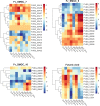Transcriptomic Response of Fusarium verticillioides to Variably Inhibitory Environmental Isolates of Streptomyces
- PMID: 37746240
- PMCID: PMC10512263
- DOI: 10.3389/ffunb.2022.894590
Transcriptomic Response of Fusarium verticillioides to Variably Inhibitory Environmental Isolates of Streptomyces
Abstract
Fusarium verticillioides is a mycotoxigenic fungus that is a threat to food and feed safety due to its common infection of maize, a global staple crop. A proposed strategy to combat this threat is the use of biological control bacteria that can inhibit the fungus and reduce mycotoxin contamination. In this study, the effect of multiple environmental isolates of Streptomyces on F. verticillioides was examined via transcriptome analysis. The Streptomyces strains ranged from inducing no visible response to dramatic growth inhibition. Transcriptionally, F. verticillioides responded proportionally to strain inhibition with either little to no transcript changes to thousands of genes being differentially expressed. Expression changes in multiple F. verticillioides putative secondary metabolite gene clusters was observed. Interestingly, genes involved in the fusaric acid gene cluster were suppressed by inhibitory strains of Streptomyces. A F. verticillioides beta-lactamase encoding gene (FVEG_13172) was found to be highly induced by specific inhibitory Streptomyces strains and its deletion increased visible response to those strains. This study demonstrates that F. verticillioides does not have an all or nothing response to bacteria it encounters but rather a measured response that is strain specific and proportional to the strength of inhibition.
Keywords: Fusarium verticillioides; Streptomyces; fungal beta-lactamase; microbial interactions; mycotoxins; transcriptome.
Copyright © 2022 Satterlee, Williams, Nadal, Glenn, Lofton, Duke, Scheffler and Gold.
Conflict of interest statement
The authors declare that the research was conducted in the absence of any commercial or financial relationships that could be construed as a potential conflict of interest.
Figures







References
-
- Andrews S. (2010) FastQC: A Quality Control Tool for High Throughput Sequence Data. Available at: http://www.bioinformatics.babraham.ac.uk/projects/fastqc.
-
- BIOMIN World MYCOTOXIN survey report . (2021) Available at: https://www.biomin.net/science-hub/world-mycotoxin-survey-impact-2021/.
LinkOut - more resources
Full Text Sources

